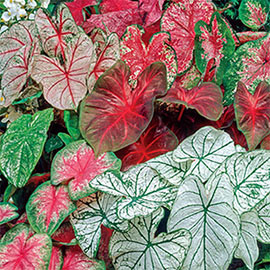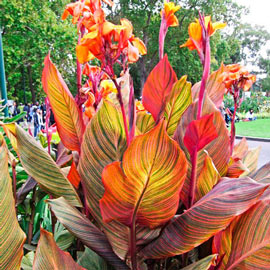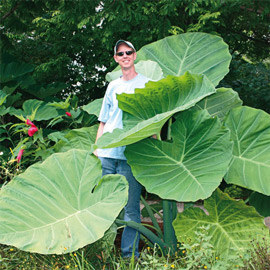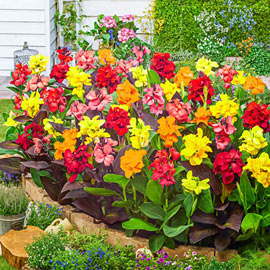Tropical Plants for Sale at K. van Bourgondien
We offer a range of
Caladiums,
Cannas, and
Elephant Ears— each one a perfect addition to any garden that lacks flamboyance and flair. To make planting easier, choose a collection of our tropical plants for sale that can be planted together or separated into pots or garden beds. Tropical plants can also be grown as indoor houseplants.
What are the easiest tropical plants to grow?
Looking for some tropical plants that are easy to grow outdoors? The following plants generally require little maintenance and thrive in warm, sunny conditions, making them great choices for outdoor gardens in warmer climates:
Hibiscus—It's known for its large, colorful flowers and ability to thrive in warm, sunny conditions. Prefers growing in soil that drains well and to receive regular watering.
Elephant Ear—Produces enormous, elephant ear-shaped leaves and thrives in warm, humid conditions. It prefers partial to full shade and regular watering.
Canna—Adds flair to the garden with its large leaves and showy flowers that come in many colors. Prefers growing in full sun and well-drained soil.
What are the best tropical plants for the house?
Given proper care, caladiums are tropical plants that are very rewarding as indoor houseplants. They are prized for the lovely colors and fascinating patterns of their attractive foliage. The plants prefer warm, humid conditions and indirect light, so they are well suited for growing indoors.
To grow caladiums indoors, place them in a well-lit room that receives indirect sunlight during most of the day. Avoid putting them in direct sunlight, as this can cause the leaves to burn. Caladiums also require high humidity. If you need to provide additional moisture to the air in the room, either use a humidifier or place a tray of water near the plant.
Finally, be sure to regularly water your caladiums, keeping the soil moist. Allow the soil to dry out a bit between waterings to prevent overwatering, which can lead to root rot.
Do tropical plants need direct sunlight?
Tropical plants typically require plenty of sunlight to thrive, but not necessarily direct sunlight. In their natural environment, tropical plants often grow beneath the canopy of taller trees, receiving dappled or filtered sunlight rather than direct sunlight.
The amount of sun that a tropical plant needs depends on the particular species and its natural habitat. Some tropical plants require full sun to grow and bloom properly. Others prefer filtered or indirect sunlight and tend to thrive in shadier areas. Generally speaking, most tropical plants will do well with bright, indirect light for several hours a day, but direct sunlight for prolonged periods can be too intense and damaging for some species.
It's important to research the specific needs of each tropical plant you obtain before planting it, so you can provide it with optimal growing conditions. In addition, remember to monitor the amount of sunlight your tropical plants receive, and then adjust their placement or provide some shading as needed to prevent them from being damaged by too much direct sunlight.
How do you store tropical plants?
Storing tropical plants can be a challenge, especially if you live in a region that experiences cold weather or has distinct seasonal changes. Here are some tips for gardeners to store tropical plants during unfavorable weather conditions or when they are not in use:
Bring them indoors. The best way to store tropical plants is to bring them inside your home or put them in your greenhouse, where the temperature and humidity can be controlled. Choose a bright, sunny location with good air circulation, ideally near a south- or east-facing window.
Maintain temperature and humidity. Tropical plants thrive in warm temperatures, typically between 60-85°F (15-29°C). Ensure that the indoor space you choose can maintain this temperature range. Also, keep humidity levels between 50% and 70% to simulate their natural environment. Try using a humidifier or misting the plants regularly.
Light. Most tropical plants need bright, indirect sunlight for proper growth. Position the plants near a window with filtered sunlight or use artificial lighting, such as fluorescent or LED grow lights, if the natural light is not sufficient.
Soil and drainage. Use good-draining, high-quality potting mix designed for tropical plants, to ensure proper moisture retention and aeration. Make sure the pots have drainage holes to prevent waterlogging.
Watering and fertilizing. Water tropical plants when the top layer of soil feels dry to the touch. Avoid overwatering, which can lead to root rot and other issues. Reduce fertilizer application as well, since the plants will be growing at a slower rate.
Pruning. Regularly remove dead leaves and spent flowers to promote healthy growth.
Inspecting for pests and diseases. Before bringing your tropical plants indoors, thoroughly inspect them for pests and diseases. If you find any, treat the plants accordingly to avoid spreading the problem to your indoor plants.
Proper spacing. Provide ample space between plants to ensure good air circulation and prevent the spread of diseases.
Acclimate the plants. When you are ready to move the plants back outside, gradually acclimate them to the outdoor conditions by placing them in a shaded spot for a few days, then slowly moving them to their final outdoor location over the course of a week or two.
Overwintering. Some tropical plants can be stored as dormant bulbs or rhizomes during the winter months. Cut back foliage, dig up the bulbs or rhizomes, and store them in a cool, dark and dry place like a basement or garage.
By following these guidelines, you can successfully store tropical plants, and keep them healthy and thriving.









